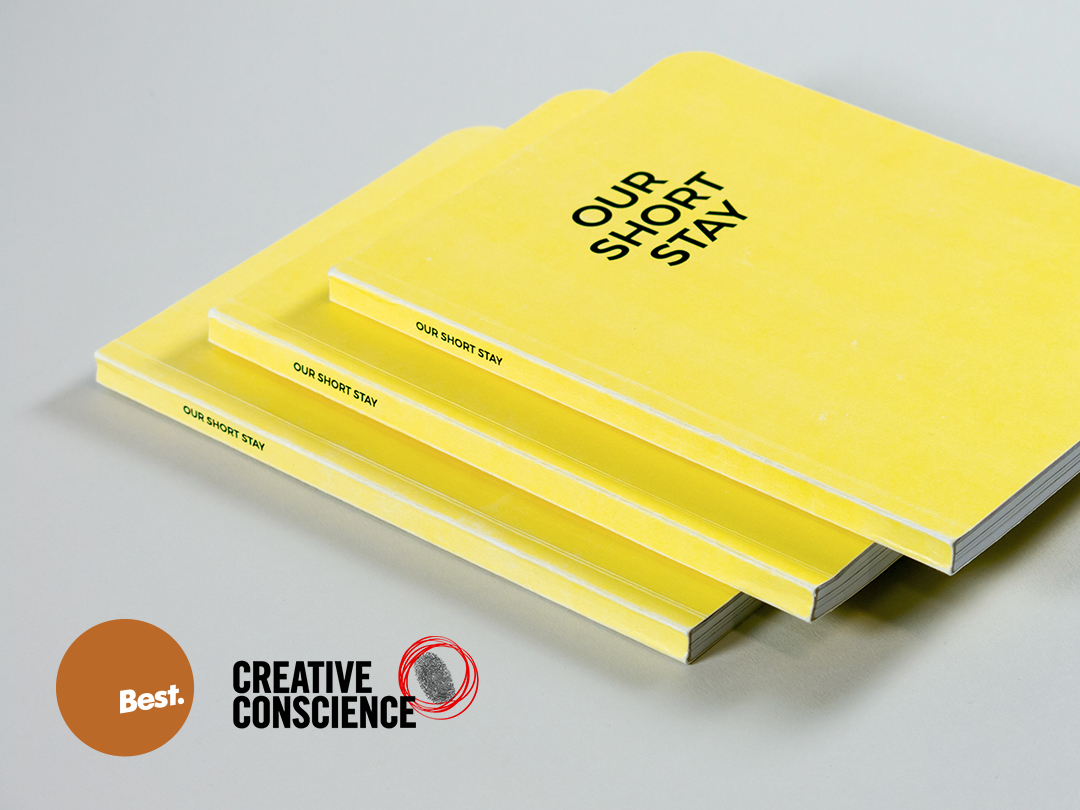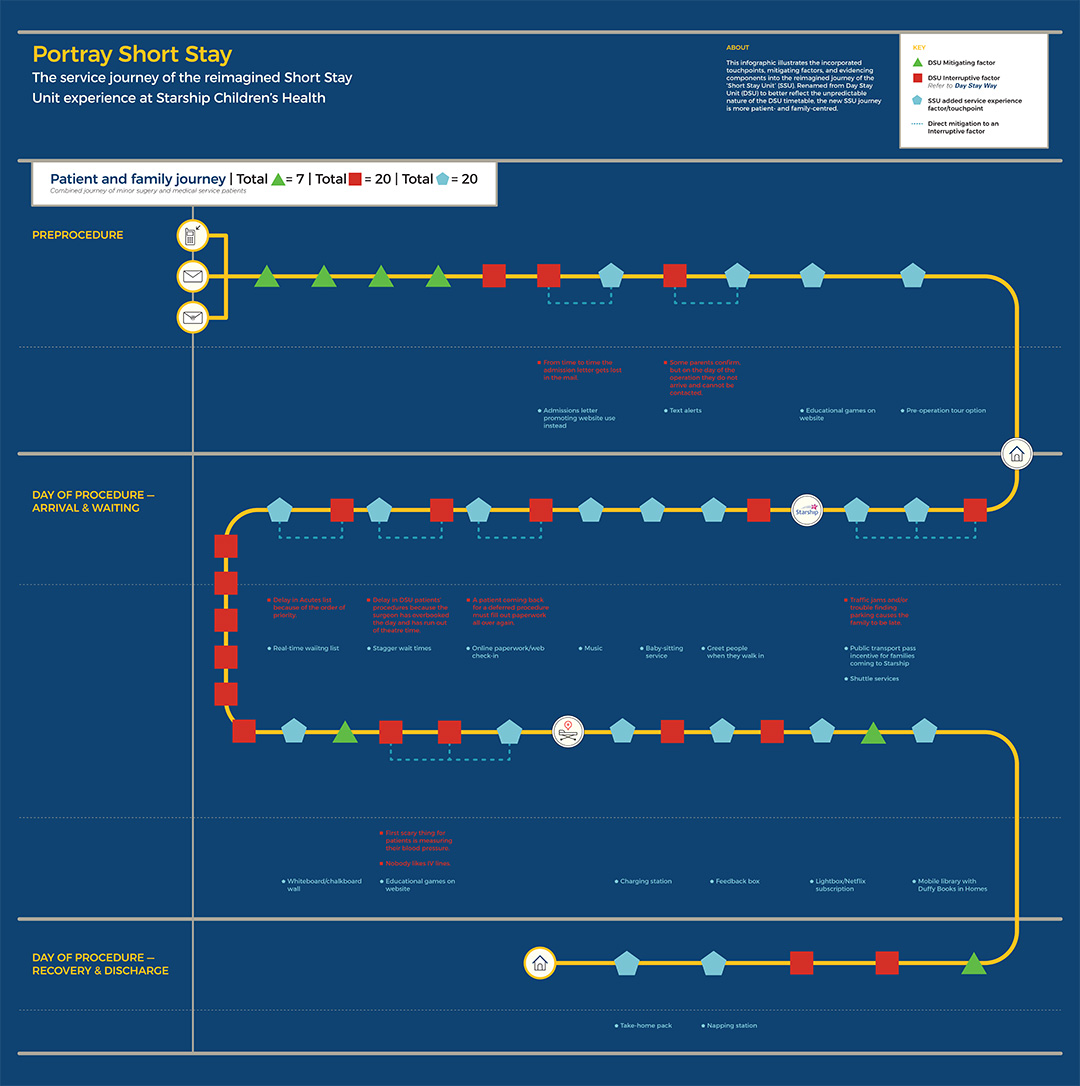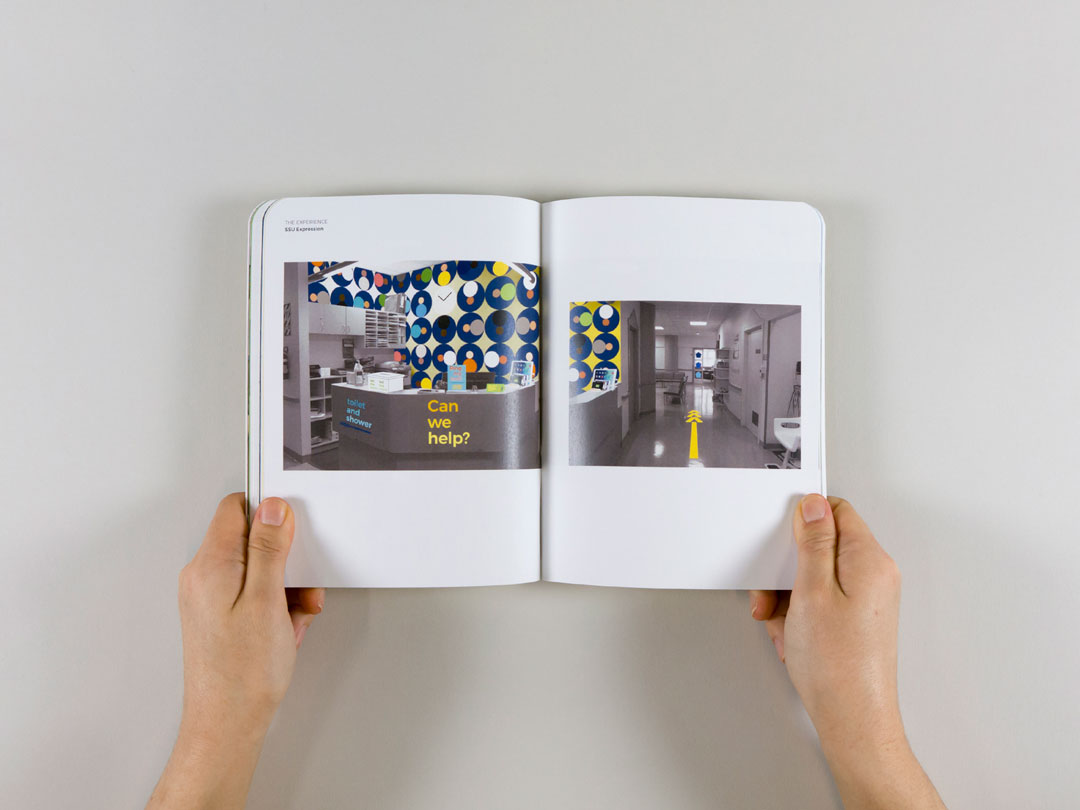How can design improve patient experience when up against hospital bureaucracy?
Reimagine your hospital unit as a brand, and let branding principles guide its potential to be lovable

Accolades
Awarded with First Class Honours (from AUT University, New Zealand)
Bronze winner in the Student Public Good category at the 2017 Best Awards (New Zealand)
Highly commended in the Graphics category at the 2017 Creative Conscience Awards (UK)
Bronze winner in the Student Public Good category at the 2017 Best Awards (New Zealand)
Highly commended in the Graphics category at the 2017 Creative Conscience Awards (UK)
Summary
CLIENT
Starship Children’s Health; DHW Lab (New Zealand)
SECTOR
Healthcare; Academia
DURATION
10 month Honours project, 2016
Starship Children’s Health; DHW Lab (New Zealand)
SECTOR
Healthcare; Academia
DURATION
10 month Honours project, 2016
RESPONSIBILITIES
Design research, Academic writing, Graphic design, Infographic design, Experience design thinking, Human centred design, Service design
STAKEHOLDERS
AUT University: Primary and Secondary Postgraduate Supervisors
Starship Children’s Health: Day Stay Unit team
View the exegesis︎︎︎
Design research, Academic writing, Graphic design, Infographic design, Experience design thinking, Human centred design, Service design
STAKEHOLDERS
AUT University: Primary and Secondary Postgraduate Supervisors
Starship Children’s Health: Day Stay Unit team
View the exegesis︎︎︎
Objective
My Honours year project with Starship Children's Health was an open brief with a simple goal: use design to improve the hospital experience for families and patients of the Day Stay Unit (DSU). The project was sponsored by DHW Lab, a joint design studio venture between AUT University and Auckland City Hospital.
Approach
At the project’s start I was a graphic design student with scant exposure to Human Centred Design, User Experience Design, Design Research, etc. Even without adequate knowledge of design thinking methods, it was obvious to me that asking parents and caregivers of DSU patients would be an appropriate way forward. Surely their perspective would point to a worthwhile problem I could focus on. I later learned this techique is called Intercept Interviews. I further supplemented my contextual research with non-participant observations of the DSU waiting area, and expert interviews with appropriate Starship staff.
As I learned about the experiences of DSU patients, parents, and caregivers, I realised this project cannot be solved with a specific design solution. These people were dealing with systemic service delivery problems. No brochure could fix that! So what does it mean to improve someone's experience through design? What can a graphic designer do against the healthcare Wicked Problem?
As I learned about the experiences of DSU patients, parents, and caregivers, I realised this project cannot be solved with a specific design solution. These people were dealing with systemic service delivery problems. No brochure could fix that! So what does it mean to improve someone's experience through design? What can a graphic designer do against the healthcare Wicked Problem?
This turning point evolved my understanding of design application. It’s not just a craft, design can be an analytical and strategic tool. My project was about problem-defining, not problem-solving


Insight
I wanted to present my discovery research findings in an elevated yet approachable way. So I created an A0-sized infographic poster series of DSU processes. I later learned in the world of Service Design, the type of visualisations I created are called Service Blueprints and Touchpoint Journeys. With these visualisations I could clealy see for myself and show others every single touchpoint of the DSU service journey. I wanted to find a problem to focus on, and through crafting these holistic maps, I could see all of them. The problem was the entire journey.
To do my research participants justice, and address the patient journey’s problems at its core, I needed to boldly reimagine the entire DSU journey.



Solution
Human touchpoints of a service experience happen to be the most impactful one for users. The nurses of DSU were beloved, but the other touchpoints were letting down the overall experience and lingering sentiment towards DSU.
Because of my graphic design and creative advertising background, I could see parallels between beloved services and beloved brands. Brands can be loved by its audience if its experience is good, and good brand experiences can be summarised as 3 C’s:
My reimagining propositions the DSU as a brand too. The 3 C’s branding principles guided my new journey’s coherence, credibillity, and consistency. It’s captured through a handbook titled ‘Our Short Stay’. I’ve renamed the Day Stay Unit into Short Stay Unit (SSU) to better reflect the unpredictable nature of the DSU timetable.
![]()
![]()
![]()
![]()
Because of my graphic design and creative advertising background, I could see parallels between beloved services and beloved brands. Brands can be loved by its audience if its experience is good, and good brand experiences can be summarised as 3 C’s:
- Coherent — the whole experience fits together. There are few speed bumps or jarring touchpoints
- Credible — the organisation’s actions and visual communications align with their identity, vision, and values
- Consistent — only through consistency can an organisation establish authenticity and trust
My reimagining propositions the DSU as a brand too. The 3 C’s branding principles guided my new journey’s coherence, credibillity, and consistency. It’s captured through a handbook titled ‘Our Short Stay’. I’ve renamed the Day Stay Unit into Short Stay Unit (SSU) to better reflect the unpredictable nature of the DSU timetable.




Reflection
The factors that contribute to a negative DSU experience are often small, uncontrollable, or caused by the ingrained bureaucratic system. Design may not ever be able to solve these. Instead ‘Our Short Stay’ is an aspirational book that attempts to show design’s potential impact on improving health seekers’ experiences.
This project was awarded with First Class Honours. It’s also a Bronze winner in the Student Public Good category at the 2017 Best Awards, and Highly commended in the Graphics category at the 2017 Creative Conscience Awards.
View the exegesis︎︎︎ and full resolutions of Day Stay Way and Day Stay Relay.
By showing Starship what this reconceptualised experience might look and feel like, we can promote a culture change amongst staff — there are no limits to improving experience when users are championed as the centre.
This project was awarded with First Class Honours. It’s also a Bronze winner in the Student Public Good category at the 2017 Best Awards, and Highly commended in the Graphics category at the 2017 Creative Conscience Awards.
View the exegesis︎︎︎ and full resolutions of Day Stay Way and Day Stay Relay.








